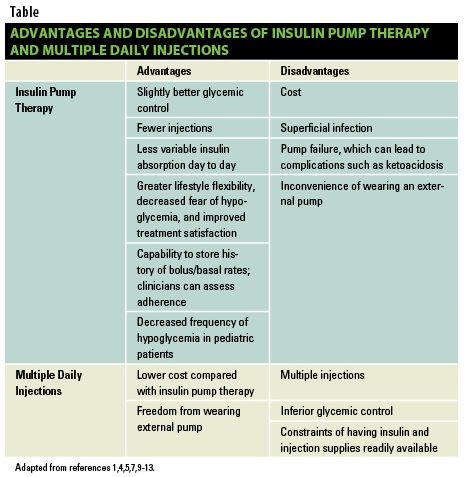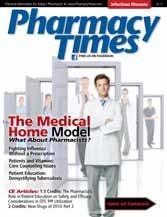Insulin Pump Therapy and Continuous Glucose Monitoring
Insulin pump therapy and continuous glucose monitoring systems can be invaluable tools for patients with type 1 and type 2 diabetes.
Insulin pump therapy and continuous glucose monitoring systems can be invaluable tools for patients with type 1 and type 2 diabetes.
Diabetes mellitus is a chronic disease characterized by elevated levels of blood glucose. To prevent diabetes complications, high blood glucose must be controlled with diet, exercise, and medications.1 Type 1 diabetes occurs when the pancreas cannot supply adequate amounts of insulin to regulate blood glucose levels due to a cellular-mediated autoimmune response, which destroys the pancreatic beta-cells.2 The most common diabetes is type 2 diabetes mellitus (T2DM), in which patients no longer produce sufficient amounts of insulin and are insulin resistant.2 Insulin is the key for unlocking the cells to allow glucose to act as a fuel to create energy. Insulin is indicated for all patients with type 1 diabetes, most patients with gestational diabetes when diet is not enough to achieve control, and patients with T2DM who cannot control blood glucose levels with other forms of therapy.
Therapy for Type 1 Diabetes
The Diabetes Control and Complications Trial (DCCT) concluded that intensive insulin therapy was superior to conventional therapy in improving glycemic control and slowing the progression of retinopathy, nephropathy, and neuropathy in patients with type 1 diabetes.1 The study defined conventional therapy as 1 or 2 insulin injections daily. Intensive insulin therapy was considered to be 3 or more insulin injections daily or the use of an insulin pump, which provides continuous subcutaneous insulin infusion.
The American Diabetes Association (ADA) and American Association of Clinical Endocrinologists’ recommendations for type 1 diabetes concur with the DCCT results.2,3 Multiple daily injections or insulin pump therapy are the 2 options preferred for patients. Choosing the appropriate regimen is usually dependent upon the patient’s preference, lifestyle, and self-care capabilities, as well as cost.
According to several major clinical trials, insulin pump therapy was more efficient in reducing blood glucose levels than the multiple daily injections.1,4,5 Using an insulin pump can help maintain tighter glycemic control without dramatically hindering the patient’s lifestyle.6 Because of cost differences and the inconvenience of being attached to a device, the use of insulin pumps is less common.7 The pump is a small, programmable device that contains a reservoir of rapid-acting insulin. The reservoir is connected by narrow tubing to a plastic cannula (not a needle, but a soft, flexible tube) that lies under the skin. A fine needle is used to help insert the cannula subcutaneously (usually around the abdomen, thigh, or upper buttocks), but the needle is removed once the cannula is placed. The cannula is replaced every 2 or 3 days; patients will only need to be punctured by a needle every 2 or 3 days compared with when insulin is used multiple times daily. The pump is programmed to deliver a predetermined amount of basal insulin throughout the day. The versatility and simplicity of the pump vary depending on the manufacturer. Typical features include the ability to program and deliver different types of boluses and basal rates, as well as set alarms and reminders. Pumps have bolus calculators as well.

Although previous studies showed that insulin pump therapy was more effective than multiple daily insulin injections in reducing blood glucose levels,1,4,5 a metaanalysis of 15 randomized controlled trials showed marginal benefit (additional 0.2% reduction in A1C) for patients with type 1 diabetes.8 It also concluded there were little to no differences in efficacy for patients with T2DM.8 When deciding between insulin pump therapy and multiple daily injections, one must take into account the advantages and disadvantages of both regimens (Table1,4,5,7,9-13). There are definitely times during which insulin pump therapy should be considered over multiple daily injections (Table 2). As pump technology and insulin pharmacokinetics become more advanced, we may approach a clearer picture of which regimen is superior overall.
Continuous Glucose Monitoring
The FDA has approved 4 continuous glucose monitoring (CGM) systems (Abbott’s FreeStyle Navigator CGM System, Dexcom’s Seven Plus CGM System, and Medtronic’s Guardian Real- Time CGM and MiniMed Paradigm Revel insulin pump). They can measure and record blood glucose levels continuously and can record up to 288 glucose measurements in a 24-hour period. If using Medtronic’s insulin pump and their CGM together, patients’ data are transmitted from the CGM to the insulin pump. CGM systems have great potential and may help control daily fluctuating blood glucose. Features include recording trends for up to 3 days, alerting patients of high and low glucose levels in real time, and measuring blood glucose every minute then transmitting the 5-minute average reading to the pump.14 A recent study showed that using a CGM for at least 6 days a week can lead to significant decreases in A1C.15
Table 2. When to Consider Insulin Pump Therapy
Conditions when insulin pump therapy should be considered:
1. Recurrent severe hypoglycemia.
2. Wide fluctuations in blood glucose levels regardless of A1C.
3. Suboptimal diabetes control (ie, A1C exceeds target range for age).
4. Microvascular complications and/or risk factors for macrovascular complications.
5. Good metabolic control but insulin regimen that compromises lifestyle.
Populations for whom insulin pump therapy may be beneficial:
1. Young children, especially infants and neonates.
2. Adolescents with eating disorders.
3. Children and adolescents with a pronounced dawn phenomenon.
4. Children with needle phobia.
5. Pregnant adolescents, ideally before conception
6. Ketosis-prone individuals
7. Competitive athletes
Adapted from reference 14.
Currently, CGMs are starting to be used more and may be most valuable in patients with a history of severe hypoglycemia. The caveats of CGMs are that they are expensive ($900 per 10 of the replaceable sensors) and they read blood glucose via the interstitial fluid, causing an approximately 20-minute delay in readings. 16 Patients will still need to measure their blood glucose levels via traditional finger sticks due to the delays.17 CGMs and pumps working together may perhaps pave the way to closing the loop of insulin delivery and creating a successful artificial pancreas in the near future.6
Therapy for Type 2 Diabetes
Of all the agents used for the treatment of diabetes, insulin is the most effective at lowering high blood glucose.18 The ADA recommends that patients with T2DM be prescribed metformin in conjunction with lifestyle interventions at diagnosis.18 Two to 3 months after the initiation of metformin, A1C levels should be retested and additional medication considered if A1C levels are above 7%.18 The consensus regarding the medication to add is either a sulfonylurea if the A1C is 7% to 8.5% or basal insulin if the A1C is above 8.5%.18 Thiazolidinediones, meglitinides, alpha-glucosidase inhibitors, dipeptidyl peptidase-4 inhibitors, and incretins are other medications used for T2DM.
There are 4 major categories of insulin. The rapid-acting insulin analogs, which currently most closely mimic a healthy postprandial pancreas’ response, are lispro, glulisine, and aspart. These 3 agents have been shown to produce less hypoglycemia with a more favorable dosing timeframe than insulin regular. Furthermore, the long-acting insulin analogs, such as glargine and detemir, have allowed for once-daily dosing (occasionally twice daily) of basal insulin compared with intermediate neutral protamine Hagedorn (NPH), which is usually administered twice daily. There is no maximum dose when titrating insulin for pharmacotherapeutic response.18
Patients with T2DM will often require a higher dose of insulin than those with type 1 diabetes due to the insulin resistance that is prominent in patients with T2DM.18 Patients with T2DM will usually initiate insulin use with bedtime intermediate NPH or either bedtime or morning long-acting insulin (glargine, detemir) as adjunctive therapy to their other medication(s).18
Although insulin reservoirs built for insulin pump therapy and the actual pumps are typically ordered directly from the manufacturer, pharmacists must keep abreast of these treatment regimens to provide optimal patient care.
Dr. Pham is a diabetes pharmacist at the Mary & Dick Allen Diabetes Center at Hoag Hospital and assistant professor of pharmacy practice at Western University of Health Sciences, College of Pharmacy. Dr. Iyer is an endocrinologist and medical director of the Mary & Dick Allen Diabetes Center at Hoag Hospital. Mrs. Woodring is a certified diabetes educator and nurse at the Mary & Dick Allen Diabetes Center at Hoag Hospital. Mr. Vuu and Ms. McArthur are PharmD candidates at Western University of Health Sciences, College of Pharmacy.
References
1. The Diabetes Control and Complications Trial Research Group (DCCT). The effect of intensive treatment of diabetes on the development and progression of long-term complications in insulin-dependent diabetes mellitus. N Engl J Med. 1993;329:977-986.
2. Rodbard H, Blonde L, Braithwaite S, et al. American Association of Clinical Endocrinologists medical guidelines for clinical practice for the management of diabetes mellitus (AACE). Endocr Pract. 2007:13(suppl 1):1-66.
3. American Diabetes Association: Standards of medical care in diabetes — 2010. Diabetes Care. 2010;33(suppl. 1):S11-61.
4. UK Prospective Diabetes Study Group: Tight blood pressure control and risk of macro vascular and micro vascular complications in type 2 diabetes (UKPDS 38). BMJ. 1998;317:703-713.
5. Jeitler K, Horvath K, Berghold A, et al. Continuous subcutaneous insulin infusion versus multiple daily insulin injections in patients with diabetes mellitus: systematic review and meta-analysis. Diabetologia. 2008;51(6):941-951.
6. Sherr J, Tamborlane W. Past, present, and future of insulin pump therapy: better shot at diabetes control. Mt Sinai J of Med. 2008;75:352-361.
7. DCCT Research Group. Resource utilization and costs of care in the diabetes control and complications trial. Diabetes Care. 1995;18:1468-1478.
8. Neithercott, Tracey. Insulin pumps and infusion sets. Diabetes Forecast. January 2010. http://forecast.diabetes.org/insulin-pumps.
9. Fatourechi, MM, Kudva YC, Murad MH, Elamin MB, Tabini CC, Montori VM. Clinical review: Hypoglycemia with intensive insulin therapy: a systematic review and meta-analyses of randomized trials of continuous subcutaneous insulin infusion versus multiple daily injections. J Clin Endocrinol Metab. 2009;94(3):729-740.
10. Sindelka G, Heinemann L, Berger M, Frenck W, Chantelau E. Effect of insulin concentration, subcutaneous fat thickness and skin temperature on subcutaneous insulin absorption in healthy subjects. Diabetologia. 1994;37(4):377-380.
11. Mecklenburg RS, Benson EA, Benson JW Jr, et al. Acute complications associated with insulin infusion pump therapy. Report of experience with 161 patients. JAMA. 1984;252(23):3265-3269.
12. Nicoucci A, Maione A, Franciosis M, et al. Quality of life and treatment satisfaction in adults with type 1 diabetes: a comparison between continuous subcutaneous insulin infusion and multiple daily injections. Diabet Med. 2008;25:213-220.
13. Pankoska E, Skorka A, Szypowska A, Lipka M. Memory of insulin pumps and their record as a source of information about insulin therapy in children and adolescents with type 1 diabetes. Diabetes Technol Ther. 2005;7:308-314.
14. Jeha GS, Karaviti LP, Anderson B, et al. Insulin pump therapy in preschool children with type 1 diabetes mellitus improves glycemic control and decreases glucose excursions and the risk of hypoglycemia. Diabetes Technol Ther. 2005;7:876-884.
15. Phillip M, Battelino T, Rodriguez H, et al. Use of insulin pump therapy in the pediatric age-group: consensus statement from the European Society for
Paediatric Endocrinology, the Lawson Wilkins Pediatric Endocrine Society, and the International Society for Pediatric and Adolescent Diabetes, endorsed by the
American Diabetes Association and the European Association for the Study of Diabetes. Diabetes Care. 2007;30:1653-1662.
16. www.medtronic.com/for-healthcare-professionals/products-therapies/diabetes/continuous-glucose-monitors/index.htm. Accessed November 4, 2010.
17. www.dexcom.com/products. Accessed July 7, 2010.
18. www.abbottdiabetescare.com/adc_dotcom/url/home/en_US. Accessed July 30, 2010.
19. www.minimed.com/products/insulinpumps/components/cgm.html. Accessed July 2, 2010.
20. Juvenile Diabetes Research Foundation Continuous Glucose Monitoring Study Group (2008). Continuous glucose monitoring and intensive treatment of type 1 diabetes. N Engl J Med. 2008;359(14):1464-1476.
21. E Rirvela, Medtronic Customer Service, 1-800-328-2518. It can take up to 20 minutes for the readings compared to the traditional finger stick readings. July 7, 2010.
22. Monsod TP, Flanagan DE, Rife F, et al. Do sensor glucose levels accurately predict plasma glucose concentrations during hypoglycemia and hyperinsulinemia? Diabetes Care.2002;25(5):889-893.
23. Nathan DM, Buse JB, Mayer MB, et al. Medical management of hyperglycemia in type 2 diabetes: a consensus algorithm for the initiation and adjustment of therapy: a consensus statement of the American Diabetes Association and the European Association for the Study of Diabetes. Diabetes Care. 2008;31:1-11.

